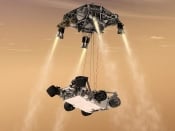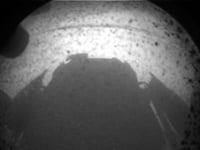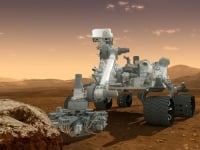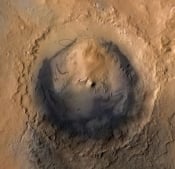Space Foundation News
Congratulations Curiosity: Enjoy Your New Home!
Written by: developer
 The Space Foundation congratulates NASA and the Jet Propulsion Laboratory (JPL) on the successful landing of the Curiosity Mars rover on the Red Planet. The one-ton rover, hanging by ropes from a rocket backpack, touched down onto Mars Sunday to end a 36-week flight and begin a two-year investigation.
The Space Foundation congratulates NASA and the Jet Propulsion Laboratory (JPL) on the successful landing of the Curiosity Mars rover on the Red Planet. The one-ton rover, hanging by ropes from a rocket backpack, touched down onto Mars Sunday to end a 36-week flight and begin a two-year investigation.
The Mars Science Laboratory (MSL) spacecraft that carried Curiosity succeeded in every step of the most complex landing ever attempted on Mars, including the final severing of the bridle cords and flyaway maneuver of the rocket backpack.
 Curiosity landed at 11:32 p.m. MDT, Aug. 5, (1:32 a.m. EDT, Aug. 6) near the foot of a mountain three miles tall and 96 miles in diameter inside Gale Crater. During a nearly two-year prime mission, Curiosity will investigate whether the region ever offered conditions favorable for microbial life. Almost immediately after landing, Curiosity returned its first view of Mars, a wide-angle scene of rocky ground near the front of the rover (pictured, right).
Curiosity landed at 11:32 p.m. MDT, Aug. 5, (1:32 a.m. EDT, Aug. 6) near the foot of a mountain three miles tall and 96 miles in diameter inside Gale Crater. During a nearly two-year prime mission, Curiosity will investigate whether the region ever offered conditions favorable for microbial life. Almost immediately after landing, Curiosity returned its first view of Mars, a wide-angle scene of rocky ground near the front of the rover (pictured, right).
Confirmation of Curiosity’s successful landing came in communications relayed by NASA’s Mars Odyssey orbiter and received by the Canberra, Australia, antenna station of NASA’s Deep Space Network.
 Curiosity carries 10 science instruments with a total mass 15 times as large as the science payloads on the Mars rovers Spirit and Opportunity. Some of the tools are the first of their kind on Mars, such as a laser-firing instrument for checking elemental composition of rocks from a distance. The rover will use a drill and scoop at the end of its robotic arm to gather soil and powdered samples of rock interiors, then sieve and parcel out these samples into analytical laboratory instruments inside the rover.
Curiosity carries 10 science instruments with a total mass 15 times as large as the science payloads on the Mars rovers Spirit and Opportunity. Some of the tools are the first of their kind on Mars, such as a laser-firing instrument for checking elemental composition of rocks from a distance. The rover will use a drill and scoop at the end of its robotic arm to gather soil and powdered samples of rock interiors, then sieve and parcel out these samples into analytical laboratory instruments inside the rover.
 To handle this science toolkit, Curiosity is twice as long and five times as heavy as Spirit or Opportunity. The Gale Crater(pictured, left) landing site places the rover within driving distance of layers of the crater’s interior mountain. Observations from orbit have identified clay and sulfate minerals in the lower layers, indicating a wet history.
To handle this science toolkit, Curiosity is twice as long and five times as heavy as Spirit or Opportunity. The Gale Crater(pictured, left) landing site places the rover within driving distance of layers of the crater’s interior mountain. Observations from orbit have identified clay and sulfate minerals in the lower layers, indicating a wet history.
The mission is managed by JPL for NASA’s Science Mission Directorate in Washington. The rover was designed, developed and assembled at JPL, a division of the California Institute of Technology in Pasadena.
For more information on the mission, visit NASA’s Mars site or JPL’s Mars Science Laboratory site.


